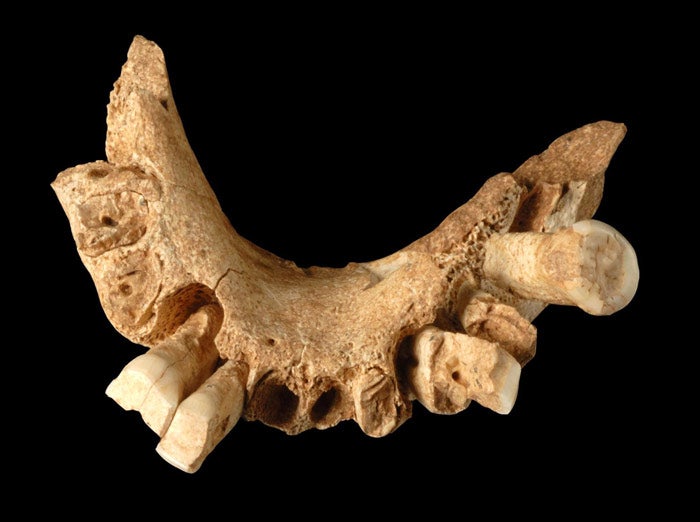Jawbone of oldest known European found in Spain

Scientists have found a jawbone belonging to the oldest known human inhabitants of Europe who lived in a lush, game-rich region of what is now northern Spain about 1.2 million years ago.
The researchers who made the discovery at the archaeological site of Atapuerca have provisionally placed the first residents of the continent in a species called Homo antecessor, or "pioneer man", which was first named 10 years ago from remains found in one of the limestone caves at the same site.
The new lower jaw has anatomical features that are both primitively ancient and more modern, suggesting that these prehistoric humans belonged to a species that may have been a common ancestor of the Neanderthals, who became extinct about 40,000 years ago, and of modern man.
However, other scientists suggest that the jawbone is more likely to be from either a side-branch of the human family tree that later died out, or an intermediate species between the more ancient H. erectus and more recent H. neanderthalensis, rather than a direct ancestor of modern H. sapiens.
A member of the research team, Jose Maria Bermudez de Castro, said that the jawbone – which contains teeth – was discovered in cave sediments alongside 32 stone tools. On the outside edge, it looks superficially similar to jawbones of H. erectus found at Dmanisi in Georgia, which date to about 1.7 million years ago, according to the study published in the journal Nature. However, the inside edge of the jaw is more modern-looking, it said.
"I think this part of human history is poorly known in Europe. We have very few fossils and artefacts. But this jawbone is the oldest human fossil we have from western Europe," said Dr de Castro, of Spain's National Centre for the Study of Human Evolution, in Burgos.
"The study of the human mandible suggests that the first settlement of western Europe could be related to an early demographic expansion out of Africa," he added.
Professor Chris Stringer, the head of human origins at the Natural History Museum in London, said that the timing of the first humans' arrival in Europe had always been controversial. "While early H. erectus fossils are known from Dmanisi in Georgia, dated to about 1.7 million years ago, the oldest European fossils, from the Gran Dolina site at Atapuerca in Spain, and from Ceprano in Italy, are only about half of that age," Professor Stringer said.
"There are sites in Spain, France and Italy which appear to have stone tools dated as far back as 1.5 million years, but these have no associated human fossils, and some workers have expressed doubts about the reliability of the dating.
"Now these excavations at another Atapuerca site, Sima del Elefante, have revealed part of the front of a human lower jaw containing several teeth, dated to about 1.1-1.2 million years ago," he said. "The jaw bone is small – perhaps from a female – and, on the outside surface, it mainly shows features found in earlier fossils of H. erectus and even H. habilis. But, on the internal surface, it is quite lightly built – an advanced feature found in later humans."
It is not known whether the species migrated to western Europe from Asia or Africa, or originated there from an ancestral stock that has yet to be identified. "However the specimen is classified, when combined with the emerging archaeological evidence, it suggests that southern Europe began to be colonised from western Asia not long after humans had emerged from Africa – something which many of us would have doubted even five years ago," he said. "I am cautious about inferring that this new find indicates that H. antecessor had originated in western Europe out of a founding population like the sample known from Dmanisi."
Join our commenting forum
Join thought-provoking conversations, follow other Independent readers and see their replies
Comments